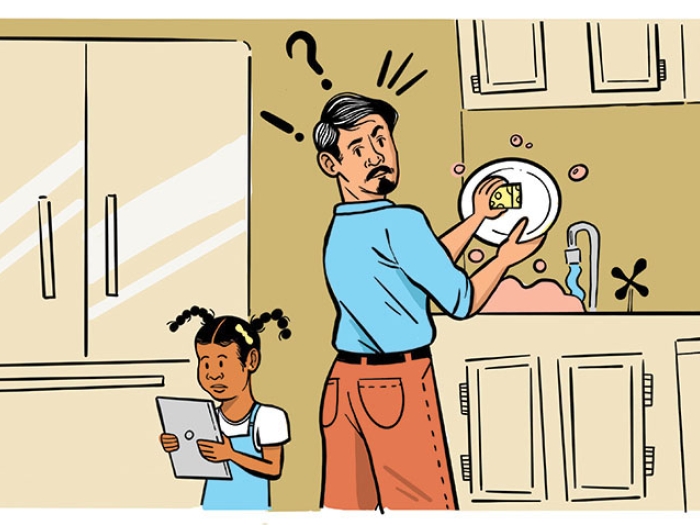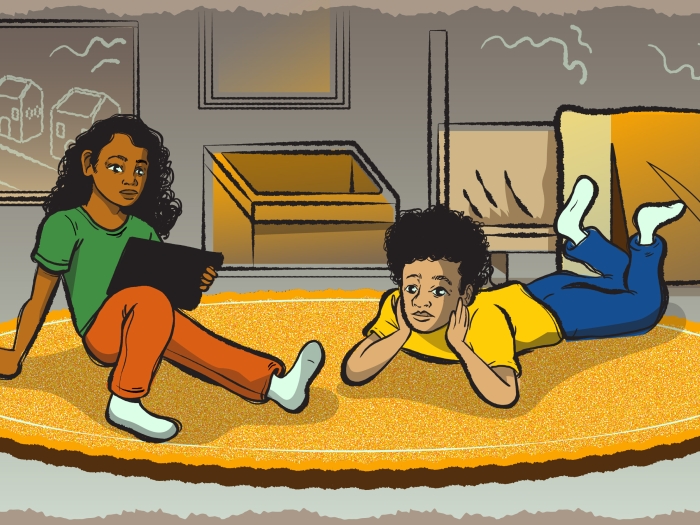Report finds children are often consuming pervasive and inappropriate advertising, violence and other questionable content while watching online videos.
11:27 AM
Author |

Young children ages eight and under are now spending more time on YouTube than ever before, with online video viewing for the first time surpassing live television and streaming video services like Netflix.
But while spending time on the world's largest free online video platform, many children are often consuming pervasive and inappropriate advertising, violence and other questionable content that isn't age appropriate, according to a new report.
In fact, one in four YouTube videos watched by children ages 0-8 were actually intended for older audiences, according to the findings by Michigan Medicine C.S. Mott Children's Hospital and non-profit organization Common Sense Media.
"With growing access to mobile devices, even very young children are becoming avid YouTube consumers, even though this platform was designed for adults," says lead author Jenny Radesky, M.D., a developmental behavioral pediatrician and researcher at Mott.
"We wanted to know to what degree kids are accessing the positive, creative, and diverse content that exists on YouTube, versus the highly commercialized, vicarious experiences – such as gaming and unboxing videos – that grab their attention but don't necessarily support their well-being."
The report sheds light on families' YouTube viewing habits on the brink of the COVID-19 pandemic, with researchers analyzing over 1,600 videos collected from 183 families between March 26 and April 1, 2020.
"YouTube is kids' favorite playground right now," Radesky says. "We have to ask whether it's being maintained in the right ways, if the equipment is safe and giving kids freedom to explore and have positive experiences? Or are they being steered towards experiences that benefit marketers and brands, but don't support their developmental growth?"
Like Podcasts? Add the Michigan Medicine News Break on iTunes or anywhere you listen to podcasts.
Despite the launch of YouTube Kids in 2015 that was encouraged for children under age 13 (which uses different filters and doesn't allow behavioral advertising), Radesky notes that a high number of children continue to engage with the main YouTube platform. Researchers evaluated children's use of the regular site, she says, because it still contains a high volume of child-directed content.
She discusses more key findings from the report below.
Ads are pervasive
The analysis found advertising in 95% of early childhood videos, with a third of videos containing three or more ads.
"We found the ad designs in these videos to be concerning, such as banner ads that blocked educational content, sidebar ads that could be confused for recommended videos, or ads for video games that showed doctored versions of popular characters, such as Peppa Pig," Radesky says.
Radesky's previous research has also found that manipulative or disruptive ad designs are prevalent in children's apps.
Of the videos children eight and under viewed, one in five also contained ads that were not age appropriate, the new report finds.
Inappropriate ads included those with violent content (e.g., ads for violent video games), sexual content (e.g., ads for lingerie), drugs/alcohol (e.g., whiskey) or politics (e.g., presidential candidates or political issues such as immigration).
Even in age-appropriate videos, inappropriate ads appeared 9-22% of the time.
Children were also exposed to indirect advertising through content in the videos they watched. Almost half of videos viewed by children eight and under featured or promoted products for them to buy.
Twenty-two percent of videos were considered high in consumerism because they centered around toys, involved YouTubers promoting their own merchandise, or prominently featured branded products.
"Some of these videos were essentially long commercials, but young kids can't recognize that, which is why we need more regulation of this content," Radesky says.
The most viewed videos are not educational
The report also finds that young children are primarily watching entertainment, not educational content.
Almost a quarter of videos children viewed were classified as educational, but with content only touching on basic educational concepts, or filling videos with toys or vicarious experiences.
Only about 4% of videos had a high educational value offering quality, developmentally appropriate content such as art lessons, well-written scientific videos, or educational programs such as Sesame Street.
Among the most popular videos were toy unboxing or toy play videos in which children just watch hands unpack or play with dolls, or a family plays with and discusses different toys or videotapes their daily play activities.
MORE FROM THE LAB: Subscribe to our weekly newsletter
"Let's Play" gaming videos were very common in this sample of young children, in which they watched a gamer play games like Minecraft or Fortnite. These videos often promoted certain merchandise to kids, involved rude language, or had age-inappropriate ads, according to the analysis.
Previous studies also suggest that popular YouTube videos targeting children promote nutritionally poor products in advertisements and in the videos themselves.
What all of these video categories have in common, Radesky says, is their goal to gain engagement through clicks, views, comments and likes so that they are prioritized in algorithms, and get recommended to more viewers. This leads to more ad revenue.
And because of these algorithms, recommendations that pop up after videos end often keep offering more of the same type of video, "which could keep kids in the same loop of suboptimal content while 'hidden gems' of positive content get buried," Radesky says.
"There's so much potential for YouTube to offer positive role models, diverse perspectives, or cool creative ideas to the young minds that love this platform, but unfortunately those videos were uncommon in our participants' viewing histories," Radesky says.
"Although great content for kids exists on YouTube, it's not rising to the top."
Violence ranks highest among negative content exposure
Twenty-seven percent of videos kids watched were not age appropriate, the report finds.
Out of all the different negative content types, children eight and under are most likely to see physical violence, with three in 10 videos (30%) containing at least mild physical violence. These included gaming videos with age-inappropriate games, such as Fortnite.
Kids are watching videos that have been designed to be the most 'engaging' – full of toys, candy, vicarious experiences – but these videos don't measure up well to what we know is most positive, educational content for kids.Jenny Radesky, M.D.
Interpersonal violence, including bullying, meanness, pranking, or other manipulative behavior, was seen in 20% of videos, including reality vlogs with pranks or crude behavior, and music videos or compilations with violence. Mild or moderate sexual content was present in about 6% of videos.
"Violence and inappropriate content popped up too frequently in the sample of videos we analyzed," Radesky says. "This raises the concern that children can easily access or stumble upon age-inappropriate content on YouTube even when engaging with content that seems to be directed to kids, such as cartoons."
"Not only do kids copy aggressive behavior, but watching YouTubers be mean and manipulative teaches kids informally that these behaviors are normal," she adds. "Now that so many children are spending a significant amount of time – many of them daily – in this digital space, these online platforms have a responsibility to keep them as safe, healthy and positive as possible."
Exposure to any of the negative content types in the YouTube study did not differ by child age, sex, parent education, income, race/ethnicity, or other characteristics.
Parents can "find the positive gems" in online videos
Many YouTube content creators may have limited training in child development, leading to poor educational quality in YouTube videos, report authors say.
"YouTube is a site that incentivizes grabbing and holding onto people's attention. Kids are watching videos that have been designed to be the most 'engaging' – full of toys, candy, vicarious experiences – but these videos don't measure up well to what we know is most positive, educational content for kids," Radesky says.
"The onus is on YouTube to make their platform either better for kids by reducing ads, making ads and content more appropriate, and elevating the good content, or to move child-directed content to the YouTube Kids platform entirely."
But until those sweeping types of changes happen, parents are still gatekeepers. Radesky notes that because of the pandemic – with long days spent quarantined and remote school – kids may be getting more screen time in general.
She advises parents to worry less about the amount of time children are on screens and more on being intentional about how that time is spent and the quality of content children are engaging with.
And quality videos on YouTube do exist, she says. They just may be harder to find because of the algorithms in place that push other videos to the top.
She recommends exploring do-it-yourself, or DIY, videos that offer simple instruction on crafts, art, music and other hands-on activities that are easy to follow along. Examples may include Art for Kids Hub, Lunch Doodles with Mo Willems, Cosmic Kids Yoga or positive story-telling videos (e.g., teachers reading books, Veggie Tales or Daniel Tiger.)
Well-researched educational content creators, such as Sesame Street and PBS KIDS, also post their videos on YouTube.
Parents should also consider diversity exposure through videos. Diverse representations and positive role modeling were only seen in 24% of videos researchers analyzed in the report.
With three in four videos missing diverse representations and positive role models, Radesky says, there is "a missed opportunity for offering children a window into a diverse set of families and perspectives through YouTube content."
The YouTube report was released simultaneously with Common Sense Media's census report, which found that more than a third of children eight and under watch online videos every day, up from 24% three years ago.
With Radesky's guidance, Common Sense media designed a flowchart to help parents identify the best content, starting with recommending they use the YouTube Kids app only.
But restricting children's access may come with some pushback at first.
"If your child is having trouble stopping watching YouTube, is arguing with you about access to it, is sneaking it, or you feel like it's otherwise having a negative effect on them – it may be because of the 'engaging' design offered to kids. It's designed to keep them watching," Radesky says.
She advises using blocks and other parental controls, like time limits set within the device's settings, to help make the transition.
"Regardless of which online video platform kids use, parents will still have to be on the lookout for consumerism, violence, ads, and a lack of positive role models," she says. "But with a little bit of planning, they can also find the hidden positive gems to help their families get the most out of online video viewing."

Explore a variety of health care news & stories by visiting the Health Lab home page for more articles.

Department of Communication at Michigan Medicine
Want top health & research news weekly? Sign up for Health Lab’s newsletters today!





